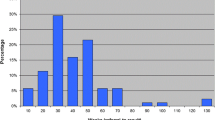Abstract
Huntington disease (HD) is a progressive neurodegenerative disorder. Presymptomatic genetic testing allows at-risk individuals to clarify their risk status. Understanding the characteristics and motivations of individuals seeking HD presymptomatic genetic testing better equips genetic counselors and other healthcare professionals to provide comprehensive and personalized care. The aims of this study were to (1) determine whether the average age when individuals seek presymptomatic HD genetic testing has decreased over time, (2) assess motivations for seeking testing, (3) explore whether there is a relationship between age and motivations, and (4) explore genetic counselors’ perceptions of the shift in age. Data from the US HD testing centers (N = 4) were analyzed. A small but statistically significant decrease in age of individuals seeking presymptomatic testing was observed (p = 0.045). HD community members (N = 77) were surveyed regarding presymptomatic testing motivations. Younger individuals were more likely than older individuals to cite “To learn whether or not you would develop HD” and “To make choices about further education or a career” compared to older individuals (p < 0.05). Conversely, older individuals more frequently cited “To give children a better idea of their risk” (p < 0.002). Sixteen percent of genetic counselors surveyed (6/37) perceived a change in age of testing. All of these respondents had provided HD testing for ten or more years and anecdotally believed the age at testing has decreased over time. Study results help providers personalize counseling based on patient’s age and serve as a starting point for more research into the relationship between age at testing and motivations for testing.


Similar content being viewed by others
References
Aro, A., Hakonen, A., & Hietala, M. (1997). Acceptance of genetic testing in a general population: age, education and gender differences. Patient Education and Counseling, 32, 41–49.
Dufrasne, S., Roy, M., Galvez, M., & Rosenblatt, D. (2011). Experience over fifteen years with a protocol for predictive testing for Huntington disease. Molecular Genetics and Metabolism, 102, 494–504.
Duncan, R., Gillam, L., Savulescu, J., Williamson, R., Rogers, J., & Delatycki, M. (2007). “Holding your breath”: interviews with young people who have undergone predictive genetic testing for Huntington disease. American Journal of Medical Genetics, 143A, 1984–1989.
Fischer, E., & Hayden, M. (2014). Multisource ascertainment of Huntington disease in Canada: prevalence and population at risk. Movement Disorders, 29, 105–114.
Koutsis, G., Karadima, G., Kladi, A., & Panas, M. (2014). Late-onset Huntington’s disease: diagnostic and prognostic considerations. Parkinsonism & Related Disorders, 20, 726–730.
Quaid, K., Swenson, M., Sins, S., Harrison, J., Moskowitz, C., Stepanov, N., et al. (2010). What were you thinking?: individuals at risk for Huntington disease talk about having children. Journal of Genetic Counseling, 19, 606–617.
Quarrell, O., O'Donovan, K. L., Bandmann, O., & Strong, M. (2012). The prevalence of juvenile Huntington’s disease: a review of the literature and meta-analysis. PLoS Currents, 4.
R Core Team. (2015). R: a language and environment for statistical computing. Vienna, Austria: R Foundation for Statistical Computing URL http://www.R-project.org/.
Shoulson, I., & Young, A. B. (2011). Milestones in Huntington disease. Movement Disorders, 26, 1127–1133.
Sizer, E., Haw, T., Wessels, T., Kromberg, J., & Krause, A. (2012). The utilization and outcome of diagnostic, predictive, and prenatal genetic testing for Huntington disease in Johannesburg, South Africa. Genetic Testing and Molecular Biomarkers, 16, 58–62.
Sparbel, K., Driessmack, M., Williams, J., Schutte, D., Tripp-Reimer, T., McGonigal-Kenney, M., et al. (2008). Experiences of teens living in the shadow of Huntington disease. Journal of Genetic Counseling, 17.
Suffham, T., & MacMillan, J. (2014). Huntington disease: who seeks presymptomatic genetic testing, why and what are the outcomes? Journal of Genetic Counseling.
Taylor, S. (2003). Predictive genetic test decisions for Huntington’s disease: context, appraisal and new moral imperatives. Social Science and Medicine, 58, 137–149.
Trembath, M., Tassicker, R., Collins, V., Mansie, S., Sheffield, L., & Delatycki, M. (2006). Fifteen years of experience in predictive testing for Huntington disease at a single testing centre in Victoria, Australia. Genetics in Medicine, 8(11), 673–680.
Warby, S., Graham, R., & Hayden, M. (2010). Gene reviews: Huntington disease. Retrieved from: http://www.ncbi.nlm.nih.gov/books/NBK1305/
Acknowledgements
Funding for the genetic counselor survey was provided by the Virginia Commonwealth University Huntington Disease Program. Study data were collected and managed using REDCap electronic data capture tools hosted at the Virginia Commonwealth University. The project was supported by CTSA award No. UL1TR000058 from the National Center for Advancing Translational Sciences. Its contents are solely the responsibility of the authors and do not necessarily represent official views of the National Center for Advancing Translational Sciences or the National Institutes of Health. This project was conducted to fulfill a degree requirement.
Author information
Authors and Affiliations
Corresponding author
Ethics declarations
Conflict of Interest
Melissa A. Holman, John Quillin, Timothy P. York, Claudia M. Testa, Ami R. Rosen, and Virginia W. Norris declare that they have no conflict of interest.
Human Studies and Informed Consent
All procedures followed were in accordance with the ethical standards of the responsible committee on human experimentation (institutional and national) and with the Helsinki Declaration of 1975, as revised in 2000 (5). Protected health information was not collected from patients included in the study, and consent was not obtained to answer the anonymous survey.
Animal Studies
No animal studies were carried out by the authors for this article.
Rights and permissions
About this article
Cite this article
Holman, M.A., Quillin, J., York, T.P. et al. The Changing Age of Individuals Seeking Presymptomatic Genetic Testing for Huntington Disease. J Genet Counsel 27, 1157–1166 (2018). https://doi.org/10.1007/s10897-018-0233-9
Received:
Accepted:
Published:
Issue Date:
DOI: https://doi.org/10.1007/s10897-018-0233-9



